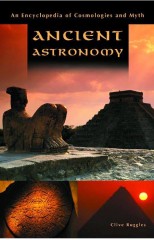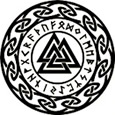
Author : Ruggles Clive
Title : Ancient astronomy An Encyclopedia of Cosmologies and Myth
Year : 2005
Link download : Ruggles_Clive_-_Ancient_astronomy.zip
Introduction. The Wonder of the Skies. The sight of a truly dark night sky is simply breathtaking. In the modern world it is denied to all but those who still live, or might occasionally venture, well beyond the glare of city lights and the effects of atmospheric pollution. For people in the past, though, the panoply of thousands of stars was a familiar sight. Some twinkled particularly brightly; others hovered on the borderline of visibility. A few were tinted orange or blue. They formed distinct patterns that moved around but never changed. The Milky Way was a familiar sight to all, snaking across the heavens with its light and dark patches forming recognizable shapes. The sky also contained numerous isolated faint and fuzzy objects (nebulae), fixed among the stars, as well as bright wandering stars (planets), and of course the moon, dominating the night sky, lighting the way by night, and rendering many of its fainter companions temporarily invisible. Added to all this was the occasional appearance of something rare or totally unexpected: a shower of meteors (shooting stars), a lunar eclipse, an aurora (at high latitudes), or—more seldom still—a comet (often perceived as a tailed or plumed star) or a new star (nova). The exact appearance of the heavenly vault differed from place to place and time to time. Whether it was visible on a particular night was dependent, of course, upon local weather conditions. However, the visual impact of the sky on a clear night was always stunning, and even in the cloudiest and wettest of places there were a good many clear periods. As a result, human communities the world over, and for many thousands of years, have recognized familiar patterns and cycles of change in the skies, as well as unexpected sights and events, and struggled to make sense of them. The inhabitants of the night sky—whether perceived as animals, fantastical creatures, legendary characters, ancestors, or other entities— were ever present. The cycles of their appearance and disappearance provided the basis for, and reinforced, countless creation stories and cultural myths. The lack of opportunity to experience the true night sky is, for a great many people in the modern Western world, something beyond their control. The same cannot be said, though, of the daytime sky, and yet few people pay much attention to it beyond worrying about the weather. Only a meager proportion—and this does not just apply to city-dwellers—could, for example, orient themselves from the time of day and the position of the sun, or could accurately describe the way in which the sun’s daily arc through the sky changes with the seasons. As a result, it can be difficult for us to imagine just how great an impact the sky, whether by night or day, had upon human cultures in the past. Yet we need look no further than the many indigenous peoples today for whom the sky continues to be of immense importance. In addition to this, certain world religions such as Islam continue to tie daily and annual observances very explicitly to the appearance of the sun and moon (see ISLAMIC ASTRONOMY). And one only has to talk to some of the older people living in rural areas, even in the world’s most densely populated and developed nations, to discover that an immense amount of practical, everyday sky knowledge was possessed even within living memory. Who, sky watchers of the past might wonder, could fail to notice the regular cycle of lunar phases keeping time with the human menstrual cycle? Who could fail to recognize the changing path taken by the sun through the sky, higher in summer and lower in winter? Who, even in an unfamiliar place, could fail to be able to tell directions and hence find their way about by night or day using the sun or stars? Perceptions of the Skies in the Past. ARCHAEOASTRONOMY can be defined as the study of beliefs and practices concerning the sky in the past, especially in prehistory, and the uses to which people’s knowledge of the skies were put. It has been recognized in recent years as a legitimate and worthwhile academic pursuit, but it also strikes a popular chord, bringing together two of the most attractive sciences, archaeology and astronomy. It combines the excitement of the cosmos with the romance of the past. Books making spectacular claims about ancient astronomical knowledge often find themselves on bestseller lists. But why should studying people’s perceptions of the skies in history, let alone in prehistory, be of particular interest or importance to scholars, not to mention anyone else, in the twenty-first century? One reason is that archaeoastronomy gives us important insights into how people in the past made sense of the world within which they dwelt. People’s lives were governed by observations of objects and events in the world around them. On one level, it is obvious that human communities needed to keep track of various seasonal markers in order to control and maintain their food supply through the year. This would be true whether they subsisted by harvesting plants, fruits, and tubers, by fishing, by hunting, by herding animals or by growing crops, or (most commonly) by a combination of these. CALENDARS, however rudimentary, were necessary for survival in all types of human society: for the smallest bands of hunter-gatherers; for farming villages controlled by local chiefs; and for complex urban societies seeking to support the higher social echelons of elite specialists, craftsmen, priests, and kings. But humans share a deeper need to understand the world that they inhabit. This does not necessarily mean seeing humankind (or the human mind) as existing within the “objective reality” of the natural environment, as is the modern scientific view, but more generally perceiving the cosmos as a conceptual whole with oneself and one’s own community embedded within it. In such a view of the world, the human body, or the dwelling house, or the sacred temple, is often seen as a microcosm reflecting and reinforcing the nature and structure of the cosmos as a whole. Such a worldview makes people strive to be at one with the cosmos of which they are a part and achieve a harmony of existence that enables individuals and whole communities to survive and flourish. This harmony is sustained by continually observing what is happening in the world and keeping one’s own actions in tune. The sky was an integral and prominent part of the perceived cosmos. Its familiar sights and unceasing cycles were part of the fabric of life. Its rhythms were correlated with the time of day and with the seasons. In fact, although we know these cycles to be unfailingly regular and reliable, to past peoples they may not have appeared any more so than a host of other seasonal indicators in the world around them. The important point for us is that, unlike the rest of their perceived world, the sky is a part that we can visualize directly. Landscapes change: patterns of settlement and land use alter, people move around, plants constantly grow and die. We only have indirect knowledge of the appearance of past landscapes. But thanks to modern astronomy, we can reconstruct mathematically the actual appearance of the sky (or, at least, the regular aspects of it—that is, the appearance of the sun, moon, planets, and stars) at any place on earth at any time in the past and visualize it on a computer display or in a planetarium. This gives us a “direct view” of a prominent part of the world that was perceived by peoples in the past. By studying knowledge passed down orally through myth and story, as well as a variety of other types of evidence available to the historian and the archaeologist, we can begin to appreciate the many different ways in which human societies came to understand what they saw in the skies, and how they came to “use” that knowledge for cultural ends. The sky could, for instance, affirm the POWER of cultural elites, as in the case of the Inca rulers, whose right to rule stemmed from their avowed relationship to the sun god himself (see CEQUE SYSTEM; CUSCO SUN PILLARS). Then again, it could reinforce the status of a shaman or priest who, by performing the appropriate rites at the appropriate times, could be seen as able to affect what happened in the sky—for example by reversing the direction of the sun at the winter solstice and preventing the days from getting ever shorter and colder. Likewise, people tend to lay out buildings in tune with the cosmos, in other words, reflecting perceived links with the wider world (see, for example, NAVAJO HOGAN; PAWNEE EARTH LODGE). Where these links relate to the sky—for instance, to the rising or setting position of the sun, moon, or stars—then we have particular hope of recognizing them, since we know where these celestial bodies appeared in the past (see HOW THE SKY HAS CHANGED OVER THE CENTURIES). By studying architectural alignments upon sky phenomena, we can obtain valuable insights into the worldviews that engendered them. There is no reason investigations of people’s perceptions of the skies should be limited to past societies, and a field known as ETHNOASTRONOMY has emerged in recent years alongside archaeoastronomy, concerned with studies of beliefs and practices relating to the sky among modern indigenous peoples. Since there is no hard line between past and present, many scholars prefer to merge the two fields and to speak instead of cultural astronomy. Regardless of how the subject is divided up, the study of people’s perceptions of the skies has a deep resonance and helps us appreciate the richness and diversity of human cognition and belief (see COGNITIVE ARCHAEOLOGY). This said, our knowledge of particular practices is always indirect, whether the evidence we are working with is ethnographic, historical, or archaeological, and questions of METHODOLOGY are highly important. For example, when studying an astronomical alignment (such as a building or temple oriented upon solstitial sunrise) it is necessary to have reasonable confidence that the alignment was actually intentional. This is not self-evident, since everything must, after all, point somewhere. In the 1970s, an abyss developed between two groups of academics regarding the interpretation of British megalithic monuments (see MEGALITHIC MONUMENTS OF BRITAIN AND IRELAND). On the one side were those who paid great attention to STATISTICAL ANALYSIS but little to anthropological theory and tended to argue that “MEGALITHIC ASTRONOMY” was highly mathematically sophisticated. On the other were those who did the reverse and reached the diametrically opposite conclusion: that ancient peoples had no interest in the sky at all. To get past this impasse, it is important to distinguish between “our” science, which provides tried and tested methods for fairly selecting and assessing evidence, and “their” science, the worldview (ancient, historical, or indigenous) we are interested in (see PALAEOSCIENCE; SCIENCE OR SYMBOLISM?). Those who are mathematically adept but anthropologically naive tend to try to show, in a proprietary way, that people in the past were our intellectual equals by demonstrating that they were capable of sophisticated mathematics and astronomy. The flaw, and also the irony, in this approach lies in the desire to measure the achievements of a past society against the yardstick of our own. This tendency, well known to anthropologists as ETHNOCENTRISM, amounts to putting our own culture on a pedestal. It is necessary to recognize that the worldview we are studying might well be logical enough in its own terms even though it does not conform in every respect to our rationality, since it is built upon different assumptions and principles. A few thousand years is nothing in human evolutionary terms, and thus people living a few thousand years ago were undoubtedly our intellectual equals: however, their way of thinking was different. We pay respect to that difference by trying to understand their way of thinking in its own terms rather than trying to make it conform to ours. It is for this reason that many prefer to avoid using the singular term astronomy to describe ancient peoples’ interest in the skies, speaking instead, if they use the term at all, of ancient astronomies. All people develop a personal view of the world. It is influenced by their own memories and experiences in which any things that may be perceived—objects, places, events, people and their actions, other living creatures, and plants—can acquire particular meanings, as can the relationships perceived to exist between them. What is more, among the countless things that make up an individual’s experience, some come to acquire more significance than others, in a selection process that can seem, to an outsider, highly arbitrary. A “discovery” that seems important to one person may be entirely overlooked or simply of no interest to another. Thus one of the Mursi, a modern group of cultivators and herders living in southwestern Ethiopia, determined the number of days that had elapsed between the planting and first harvesting of his sorghum crop by wearing a cord round his ankle and tying a new knot in it each day. However, those to whom he proudly announced the result were mildly surprised that anyone should have taken so much trouble to deduce something so irrelevant to their daily lives— something that added nothing to their total stock of knowledge about the world. Groups of people living together do, however, tend to develop common mindsets—sets of common perceptions and understandings. These worldviews are reinforced by shared experiences and social convention, and by regular communication, which in small groups is likely to take place by means of a common language. In the framework of modern Western thought, we organize what we perceive in nature according to the principles of Linnaean classification (deriving from the work of the eighteenth-century Swedish botanist Carolus Linnaeus)— that is, into a hierarchical structure of groups (taxa) based upon their observable characteristics. We also tend to believe that the universe is an empirical reality existing independently of the human mind that can progressively be understood through rational argument and scientific experimentation. Other worldviews, however, do not generally classify objects and phenomena into taxa familiar from a Western viewpoint: categories and relationships are not determined by “objective” criteria but simply by whether enough people agree on them. As a result there is generally no clear distinction between the sacred and the mundane, the animate and the inanimate, the empirically real and the fantastic; nor indeed between the terrestrial and the celestial. In traditional cultures, creatures such as fish-man or bird-woman may be seen as fellow beings, every bit as much a part of the perceived universe as entities a Westerner would identify as physically real. As an example, Old Star, chief protector of the inhabitants of the sacred He world of the Barasana of the Colombian Amazon, is at once a short trumpet, a constellation corresponding to ORION, the fierce thunder jaguar, and a human warrior. The sky is a crucial component in practically every indigenous worldview. For earlier peoples and for many indigenous groups around the world today, what we in the modern Western world separate out and categorize as astronomical and meteorological phenomena were an integral part of the environment as a whole. This total environment, including things both real and imagined, was the cosmos; the words COSMOLOGY (as widely used in anthropological literature) and cosmovisión are broadly synonymous with worldview. In non-Western worldviews, direct associations between the terrestrial and the celestial are commonplace. A good example of this is the BARASANA “CATERPILLAR JAGUAR” CONSTELLATION, whose behavior is believed to relate directly to that of earthly caterpillars, which fall out of trees and provide an important food source at a certain time of the year. ...

Davis James Kirkpatrick - Spying on America
Author : Davis James Kirkpatrick Title : Spying on America The FBI's domestic counter-intelligence...














